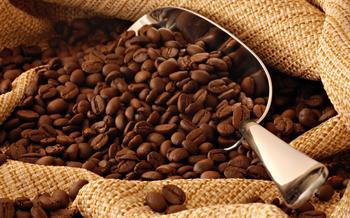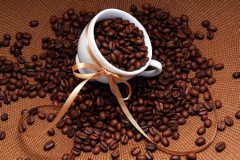Common sense of Fine Coffee beans Chemical composition of coffee
How many substances does a cup of coffee contain? Coffee extracted by traditional methods such as hand-brewing and Syphone contains more than 200 substances, while 1500 qualities can be extracted in an instant when using a Ruyi coffee machine and mocha pot. Unexpectedly, there are so many things in a cup of flavored water, the charm of coffee is made up of these substances.

The chemical composition of coffee beans is quite complex, of which carbohydrates account for the most. Coffee beans contain a variety of carbohydrates, accounting for 60% of the total weight of raw coffee beans, as well as some proteins, fats, tannins, caffeine, minerals and other trace ingredients; and variety, origin and harvest season, will affect the composition of these ingredients. The various ingredients of raw coffee beans will react in the baking process and form the unique flavor and color of all kinds of coffee beans.
1. Caffeine
Caffeine is the most eye-catching of all the ingredients of coffee. It belongs to a kind of phytoxanthine (animal muscle component). It has the same properties as theophylline contained in cocoa, green tea contains the same theophylline, and the percentage of reduction after baking is very small. Caffeine has a very extensive effect. It will affect various parts of the human brain, heart, blood vessels, gastrointestinal tract, muscles and kidneys. The right amount of caffeine will stimulate the cerebral cortex, promote sensory judgment, memory and emotional activity, and make the myocardial machinery more active. Vasodilation enhances blood circulation and improves metabolic function. Caffeine can also reduce muscle fatigue and promote digestive juice secretion. In addition to this, because it also promotes the kidney function to help the body expel excess sodium ions (chemicals that hinder the metabolism of water molecules), caffeine will not accumulate in the body like other narcotic and excitant substances (narcotic drugs, paint solvents, stimulants, etc.) and will be excreted in about two hours. The bitterness of ─, the most important feature of coffee flavor, is caused by caffeine.
2. Tannic acid
After extraction, tannic acid will turn into a yellowish powder, which can easily blend into water. When tannic acid is boiled, it will decompose and produce pyrosylic acid, which will make the coffee taste worse. If you brew it well and leave it for several hours, the color of the coffee will become stronger than when it was first brewed, and it will be less tasty, so there is the saying that "it is best to finish it as soon as possible." Usually a cup of coffee is at its best for 10 minutes. If you want to, you can try whether the taste of the same cup of coffee is the same every minute, and 10 minutes later, the taste of the coffee will be much different from that when it was first brewed.
3. Protein
The protein content of raw beans is about 13%, and the amino acids change differently during baking. Some will react with sugars to form the unique color and smell of baked products. Although coffee beans are rich in protein, but in the brewing process, the protein will not be dissolved out, so no matter how much coffee is drunk, the ingredient is still limited, but the coffee grounds has a high protein content, which is worth reusing.
4. Minerals
Mainly lime, iron, sulfur, sodium carbonate, phosphorus, chlorine, silicon and so on, because the proportion of very little affect the flavor of coffee is not big, combined to bring only a little astringent taste.
5. Sugar
Without sugar, you will not only feel the bitterness of caffeine and the sour taste of tannin, but also feel sweet, which is caused by the sugar contained in the coffee itself. After baking, most of the sugar will be converted to caramel, giving the coffee a unique brown.
6. Volatile components
The aroma of coffee is mainly produced in roasting, and there is no smell of raw coffee beans. When the coffee is first brewed for a moment, the aroma of the room floats, which is equal to half of the coffee already drunk. Coffee aroma is an important feature of its attraction, you can not drink coffee, but can not resist its aroma temptation. The volatile components are the basic elements that bring aroma to the coffee. At present, coffee flavor mixtures are known to contain more than 300 compounds, but most of them are very low. The results of gas chromatography showed that the aroma of coffee was composed of acid, alcohol, acetaldehyde, ketone, ester, sulfur compound, phenol, nitrogen compound and so on. Generally speaking, fat, protein and sugar are important sources of aroma, while lipid ingredients will blend with the sour and bitter of coffee to form a smooth taste. Therefore, the disappearance of fragrance means that the quality is getting worse, and the relationship between aroma and quality is very close.
7. Fat
Raw coffee beans contain about 13% fat. In coffee bean roasting, the fat content will be reduced accordingly, forming part of the volatile components of coffee, which is closely related to the aroma of coffee. During the storage of cooked beans, some chemical reactions such as oxidation and decomposition will occur due to the contact between the fat in the beans and the air, resulting in some compounds with bad smell, which affect the flavor of coffee beans. Therefore, coffee beans in storage, to avoid contact with the air, in order to maintain quality. But it is not good to vacuum, the coffee bean itself will emit some gas, so a better way to preserve it is to put it in a special coffee bag with an one-way exhaust valve.
8. Crude fiber
The fiber of raw beans will be carbonized after baking, which combines with the caramelization of sugar to form the hue of coffee, but the fiber turned into powder will have a considerable impact on the flavor of coffee.
Appendix:
The main chemical constituents of raw coffee beans
Component content (%)
Carbohydrate 60.0
Reducing sugar 1.0
Sucrose 7.0
Pectin 2.0
Starch 10.0
Garrison polysaccharide 5.0
Hemicellulose 15.0
Holocellulose 18.0
Lignin 2.0
Oil 13.0
Protein (Nylon 6.25) 13.0
Ash (oxide) 4.0
Tannic acid 7.0
N-methyl nicotinic acid (soluble) 1.0
Caffeine (soluble) 1.0 mg / kg 2.0
Important Notice :
前街咖啡 FrontStreet Coffee has moved to new addredd:
FrontStreet Coffee Address: 315,Donghua East Road,GuangZhou
Tel:020 38364473
- Prev

Basic knowledge of high-quality coffee beans honeycomb structure of coffee beans
I read a coffee magazine and one of the interviews was very interesting. Coffee enthusiast, Professor Yukio Hiroase of Kanazawa University in Japan, has a doctorate in engineering and specializes in computational mechanics. the boss has studied coffee beans with a hundred and twenty thousand scientific spirit and achieved the following results: 1 the interior of roasted coffee beans is honeycomb structure. different roasting methods form different honeycomb structures. 2 Honeycomb cavity
- Next

Drink Coffee Health Tips do not drink Coffee after drinking
The stimulating taste and rich atmosphere brought by the co-drinking of wine and coffee make people intoxicated and have a long history. Some people are more accustomed to sober up with coffee after dinner, but experts advise against drinking too much. Because alcohol plus coffee will aggravate the damage caused by alcohol to the human body. Drinking coffee after drinking alcohol will turn the brain from extreme inhibition to extreme excitement, stimulate vasodilation, speed up blood circulation, and greatly increase painstaking efforts.
Related
- Beginners will see the "Coffee pull flower" guide!
- What is the difference between ice blog purified milk and ordinary milk coffee?
- Why is the Philippines the largest producer of crops in Liberia?
- For coffee extraction, should the fine powder be retained?
- How does extracted espresso fill pressed powder? How much strength does it take to press the powder?
- How to make jasmine cold extract coffee? Is the jasmine + latte good?
- Will this little toy really make the coffee taste better? How does Lily Drip affect coffee extraction?
- Will the action of slapping the filter cup also affect coffee extraction?
- What's the difference between powder-to-water ratio and powder-to-liquid ratio?
- What is the Ethiopian local species? What does it have to do with Heirloom native species?

